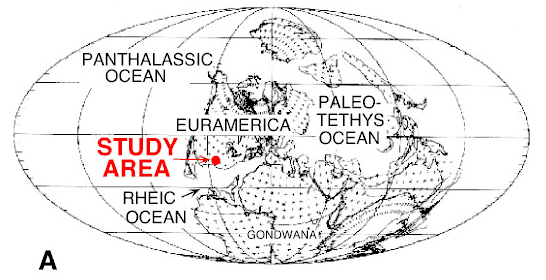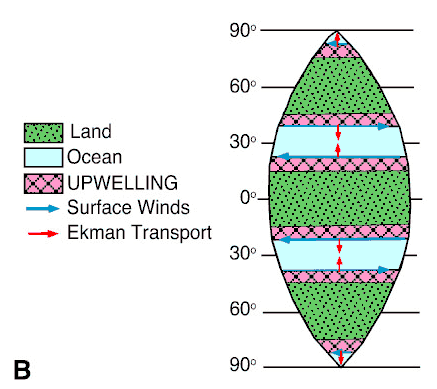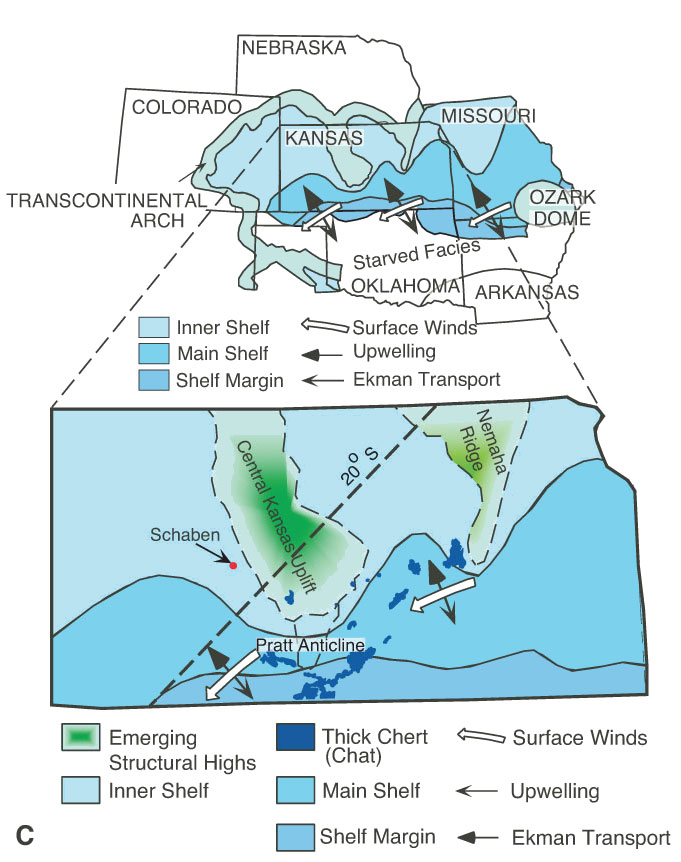Kansas Geological Survey, Current Research in Earth Sciences, Bulletin 252, part 1
Prev Page--Depositional Environments || Next Page--Conclusions, References
Kansas Geological Survey, Current Research in Earth Sciences, Bulletin 252, part 1
Prev Page--Depositional Environments ||
Next Page--Conclusions, References
![]()
As indicated earlier, studies by others (Witzke, 1990; Golanka et al., 1994; Scotese, 1999) place the Kansas study area during Early-Middle Mississippian time in a tropical/subtropical location, at about 20° S latitude and drifting north during the Carboniferous. In this setting shallow-water carbonates dominated by photozoans might be expected. In addition Gammon et al. (2000) point out that siliceous spiculites do not occur on the inner portions of shelves in subtropical and tropical environments under typical conditions. Therefore, the dominance of shallow-water biosiliceous (sponge spicule) and heterozoan carbonates in this setting in Kansas and throughout similar settings in North America during the Early-Middle Mississippian (examples discussed above) requires elevated nutrient and dissolved silica supplies that prevented the development of photozoans and promoted the development of heterozoan and siliceous sponges (James, 1997).
Elevated nutrient and dissolved silica supplies could originate from terrestrial or oceanic sources. Some studies have emphasized fluvial and ground-water sources for elevated nutrients and dissolved silica with a link to humid climate for promoting biosiliceous and heterozoan carbonate facies development in mid-latitude, shallow water (inshore) environments (e.g. Gammon et al., 2000; James and Bone, 2000; Lane, 1981; Cavaroc and Ferm, 1968; Carlson, 1994). Upwelling is another mechanism that delivers nutrient- and silica-rich cool oceanic water to shelf margins. As discussed below, a number of studies interpret upwelling as an active process that was responsible for creating the widespread development of siliceous deposits during Early-Middle Mississippian time on margins of much of the North American carbonate shelf, including the current-day Kansas region.
Lowe (1975) noted the widespread development of siliceous deposits both within the Ouachita basin and on adjacent shelf areas, especially in Upper Devonian and Lower Mississippian strata that he suggested represented unusually high regional silica levels during at least part of the Paleozoic. Maliva and Sevier (1989) suggested that Paleozoic sea water might have contained more silica than modern sea water due to inefficiency of pre-diatom biogenic precipitation. Lowe (1975) additionally thought that silica for the Ouachita basin and adjacent shelf areas may have come from volcanic sources along the orogenic zone marking the North American-Gondwana convergent plate junction. The volcanic sources enriched westerly equatorial surface currents in silica, which produced an area of silica productivity associated with sites of dynamic upwelling off the west coasts of Gondwana and North America. Lowe (1975) postulated that during relative rises in sea level, waters from this upwelling area were able to spill eastward across the Paleozoic Mexican peninsula and into the Ouachita seas.
One model to transfer cold or cool, silica-rich water in the Ouachita basin to the adjacent shelf areas is the zonal coastal upwelling model of Parrish (1982), which shows upwelling occurs on north- or south-facing coastlines that are situated at the proper latitude relative to the major zonal wind systems (fig. 13). According to Parrish (1982), zonal coastlines were more common in periods of earth's history than they are now, and zonal coastal upwelling has the potential to be extensive because it is not limited in length by the Coriolis effect or confines of zonal climate patterns. The paleogeographic setting of Kansas and the surrounding regions at ∼20° S latitude in the Osagean with a generally south-facing coastline, and the likely surface-wind patterns (fig. 13) are in favorable agreement with the zonal upwelling model of Parrish (1982).
Figure 13A--Paleogeographic setting during Kinderhookian, Osagean, Meramecian (Visean-Tournaisian) time. Note location of the study area, which was situated at ∼20° S latitude. Modified from Scotese (1999).

Figure 13B--Zonal upwelling model of Parrish (1982).

Figure 13C--Details of the regional paleogeographic setting with interpreted depositional environments, predominant wind conditions and associated upwelling based on data from Lane and DeKeyser (1980), Parrish (1982), Gutschick and Sandberg (1983), Witzke (1990), Golanka et al. (1994), and Scotese (1999). The enlarged inset also shows location of Schaben field and areas of thick accumulations of chert ("chat") in shelf margin areas (chat areas from Montgomery et al., 1998).

Nobel (1993) notes the onset of tectonism in the Ouachita System in the Late Devonian to Early Mississippian, which resulted in compartmentalization in the Ouachita basin with microcontinental fragments and constriction of the transequatorial passageway connecting the Iapetus and Panthalassic seas during the collision of Laurasia and Gondwana. The stricture of passages resulted in increased bottom-current velocities in the Early Mississippian, and the microcontinental fragments served as intermittent barriers, which allowed for development of local anoxic conditions. Vogt (1989) showed that strongly anoxic waters form in restricted basins today, and that occasional upwelling occurs in some of them. The Early Mississippian eustatic sea-level rise may have been associated with an oceanic anoxic event (Jenkyns, 1980). These elements may have contributed to conditions that were conducive to upwelling of nutrient and silica-rich waters across the shelf adjacent to the Ouachita basin.
Parrish (1982) proposed that in the latest Devonian-earliest Mississippian the most vigorous upwelling would have been southwest of the eastern highlands (present orientation) over Texas, Kansas, and Oklahoma, although she showed Kansas sitting at a position nearer the equator during this time slice, as compared to the 20° S latitude position of more recent studies (Witzke, 1990; Golanka et al., 1994; Scotese, 1999) (fig. 13). Parrish (1982) indicated that areas near the highlands would have experienced less vigorous upwelling and that the degree of upwelling influence would also have decreased to the northwest, toward the Williston basin, as the shelf became shallower in that direction. Parrish (1982) placed the richest sources of upwelling in the southwest and midwest and pointed to those areas as the most likely site for chert.
Other studies of Early-Middle Mississippian strata have also called on upwelling. Gutschick and Sandburg (1983) interpreted upwelling to have been an important factor along the margins of much of the North American carbonate shelf during the latest Tournaisian (middle Osagean). Wright (1991) interpreted Early Mississippian deposits from within and outside of North America to have resulted from upwelling. Lumsden (1988) interpreted the proliferation of sponges in the Ft. Payne in Tennessee to be due to silica supplied from upwelling waters from the open ocean troughs to the west and southwest. More recently, Lasemi et al. (1998, 2003) interpreted upwelling of nutrient- and silica-rich cool oceanic water for Early Mississippian deposits in the Illinois basin, which sat at about 20° south of the equator, a position similar to that for Kansas during the same time interval.
The above studies indicate that upwelling likely was an active regional process during Osagean deposition in Kansas. The proliferation of siliceous sponges to form buildups in present-day Kansas and Oklahoma shelf margin areas (e.g. Rogers et al., 1995; Colleary et al., 1997; Montgomery et al., 1998; Watney et al., 2001) is compatible with upwelling of basinal waters to deliver nutrients and dissolved silica to those areas. In addition, the widespread abundance of glauconite in Osagean strata in Kansas (Goebel, 1968) is considered a characteristic of upwelling sediments (Parrish, 1982). However, it is still not fully understood whether upwelling alone could be the main factor affecting the innermost shelf areas of this study, or if other factors, including elevated nutrient and dissolved-silica supplies from land sources, were important in controlling facies associations. Some considerations of these various possibilities are discussed below.
It seems plausible that upwelling conditions could have at least contributed to, if not been a dominant factor for, the facies associations observed in the inner shelf areas. As nutrients are consumed, productivity decreases away from the site of upwelling, although upwelled water may remain on the surface for some distance (e.g. Ryther et al., 1971; Barber and Smith, 1981) and an upwelling zone may span hundreds of kilometers (Parrish, 1982). As noted in Parrish (1982), the actual depth required for upwelling over a shallow shelf depends on the thickness of the Ekman layers, which include the layer at the surface containing water set into motion by wind friction and a similar layer of retarded motion caused by friction with the sea bottom. Water at the surface constitutes the outward flow in an upwelling situation and water at the bottom constitutes the return flow. As long as the two Ekman layers are separated, upwelling is possible. The thickness of the Ekman layers vary. Transitory upwelling has been observed in water as shallow as 10 m (Parrish, 1982). Considering these factors, it is possible that upwelling waters affected the inner shelf portion of this study, which was located several hundred kilometers from the shelf margin.
Sea-level rise is an effective mechanism for allowing migration of upwelling zones over vast areas of cratons (Parrish, 1982). Sloss (1963) identified a major transgression across the craton in the latest Devonian and Early Mississippian (Kaskaskia) and Lowe (1975) suggested the associated spread of epicontinental seas during this time would have promoted the flow of silica-bearing ocean water onto the craton. Additional higher frequency relative sea-level fluctuations during the Early-Middle Mississippian (Ross and Ross, 1987) may have promoted repeated upwelling events that affected areas well onto the craton, including inner-shelf locations, such as the area described in this study.
Terrestrially sourced nutrients and dissolved silica also could have contributed to facies associations in inner-shelf areas. Evidence from SB1 (sequence boundary with evidence of subaerial exposure) and local evidence in DS2 indicate that the study area was at least locally subaerially exposed at times. This suggests that the adjacent topographically positive Central Kansas uplift (CKU) area was likely intermittently subaerially exposed as well, which is corroborated by Lane and Keyser (1980) who indicate that the Transcontinental arch, including the CKU, was near base level and intermittently subaerial exposed during Mississippian time. Goeble (1968) noted that red and dark-colored shale and red crinoidal limestone interbedded with cherty limestone in early Osagean sediments were evidence of a nearby shoreline reflecting concurrent uplift of the CKU. DS2 contains some interbedded detrital silt- and clay-size siliciclastics that are likely to have been sourced from the CKU during times of subaerial exposure. Therefore, it is possible that nutrients and dissolved silica from a terrestrial source could have contributed to facies associations in the inner-shelf study area. However, several factors combine to suggest that nutrients and dissolved silica from a terrestrial source would not have been the sole, or even dominant, control on inner-shelf facies. The relatively minor amounts of interbedded siliciclastic material in DS2 suggest that durations of subaerial exposure of the land source (CKU) were not long-lived and/or the amount of river runoff (perhaps linked with climate) was not high. The abundance of evaporites in DS2 of this study and in Osagean-Meramecian strata in other areas of North America indicate aridity (Cecil, 1990; Scotese, 1999). Gammon and James (2002) suggest that arid terrestrial environments may promote shallow shelf biosiliceous sedimentation. They note that ground waters from mid-latitude arid zones are high in salinity with enhanced silica solubility and concentrations and, importantly, suggest that these salt and silica-rich ground waters are flushed to nearshore environments with a change to humid climate. Gammons and James (2002) suggest that ancient shallow shelf biosiliceous deposits may be a record of terrestrial silica export associated with mid-latitude arid to humid climate fluctuations. Although this process cannot be completely ruled out for contributing to DS2 facies associations, no evidence has been observed to date to indicate arid to humid climate fluctuations. Instead, early silica replaced evaporites are consistently abundant throughout DS2 strata indicating overall aridity. Also, other workers have indicated a change to more arid climate at the end of Osagean deposition (e.g. Cecil, 1990; Smith and Dorobek, 1993).
Oolite deposits are relatively rare in Osagean strata (compared to earlier and later Mississippian units), but have been reported from several areas. For example the Short Creek oolite, which occurs in southeastern Kansas (Cherokee County), is an Osagean deposit (fig. 2). The local, sporadic development of oolite deposits during this time interval could indicate conditions, including either land-sourced or basin-sourced nutrients, that limited their development. Interestingly, Witzke and Bunker (1996) document Osagean oolite deposits in Iowa and show Early Osagean paleogeography with an inner-shelf environment that includes common oolite shoals occurring in close proximity to emergent land and siliciclastic facies belts. This relationship argues against land-sourced nutrients limiting oolite development. Finally, reconnaissance study of other Osagean core data in Kansas (Franseen, unpublished data) suggest a general decrease shelfward (northwest) in early silica replacement and cementation, which argues against land-sourced silica supplies dominating the system.
In summary, the predominance of Early-Middle Mississippian heterozoan carbonate and biosiliceous deposits, and lack of photozoan deposits, in the mid-latitude shallow-shelf setting in Kansas and surrounding areas was likely due to abundant nutrients and dissolved silica derived from basinal and/or terrestrial sources. Based on available evidence at this time, it appears that upwelling of basinal waters rich in nutrients and dissolved silica was a primary control on shelf margin and shelf facies. Upwelling even may have had a primary imprint on shallow-water, inner-shelf areas, especially during transgression(s). Although nutrients and dissolved silica from terrestrial sources cannot be ruled out entirely for contributing to the facies associations in shallowest water, inner-shelf areas, the available evidence from this and other studies suggests elevated nutrient and dissolved silica levels in shallow-water inner shelf areas were not predominantly sourced from terrestrial environments.
Further study is needed to better understand the relative roles of basinal and terrestrial sourced nutrients and dissolved silica, other paleoceanographic conditions (e.g. salinity), and paleogeography (e.g. identification of protected embayments that may have promoted biosiliceous deposits) in controlling the nature of Early-Middle Mississippian shallow water, inner-shelf heterozoan carbonate and biosiliceous deposits in Kansas and elsewhere in North America.
Cumulative production from Mississippian reservoirs in Kansas exceeds 1 billion barrels (Adkins-Heljeson et al., 1999). In Lower-Middle Mississippian strata, production is from carbonates, cherty carbonates, and chert-dominated strata composed predominantly of heterozoan-dominated carbonate biota and biosiliceous material. Previous studies have focused on carbonate packstone-grainstones as reservoir facies in inner-shelf/ramp settings (e.g. Johnson and Budd, 1994), or, especially, the importance of chert-dominated (chat) sponge spiculitic-rich reservoir facies in deeper water shelf/ramp margin areas (Rogers et al., 1995; Colleary et al., 1997; Montgomery et al., 1998; Watney et al., 2001). As a complement to those previous studies, this study identifies another potentially important reservoir facies type for inner shelf/ramp settings. The shallow-water cherty dolomite DS2 strata of this study composed of abundant siliceous sponge spicule-rich facies (with silica replaced evaporites) and heterozoan carbonates, form reservoir facies in Schaben field (Franseen et al., 1998; Montgomery et al., 2000). Because a regional control, such as upwelling, is likely to have played a role in distribution of the shallow-water biosiliceous and heterozoan carbonate facies in DS2, the potential exists for these types of facies in Lower-Middle Mississippian strata to form reservoirs in other similar shelf settings in Kansas. This is demonstrated by recent study of time-equivalent strata in a core from Dickman field in Ness County, which indicates the reservoir interval is at least partially made up of similar shallow-marine sponge-spicule, heterozoan carbonate, and silica replaced evaporite facies (Franseen, unpublished data).
Similar facies with reservoir potential may exist outside of Kansas as well, based on the documented dominance of Early-Middle Mississippian heterozoan carbonate and biosiliceous deposits throughout North America, with several documented examples of shallow-water sponge spicule and evaporite facies that were deposited in inner-shelf/ramp settings.
Prev Page--Depositional Environments || Next Page--Conclusions, References
Kansas Geological Survey
Web version July 10, 2006
http://www.kgs.ku.edu/Current/2006/franseen/06_depo.html
email:webadmin@kgs.ku.edu